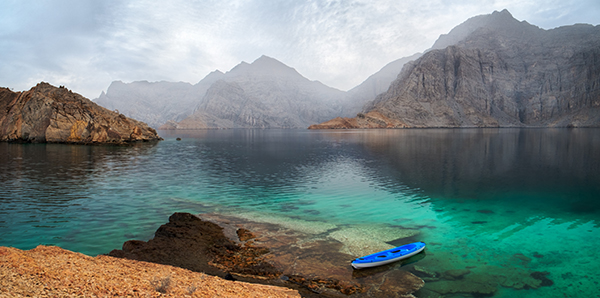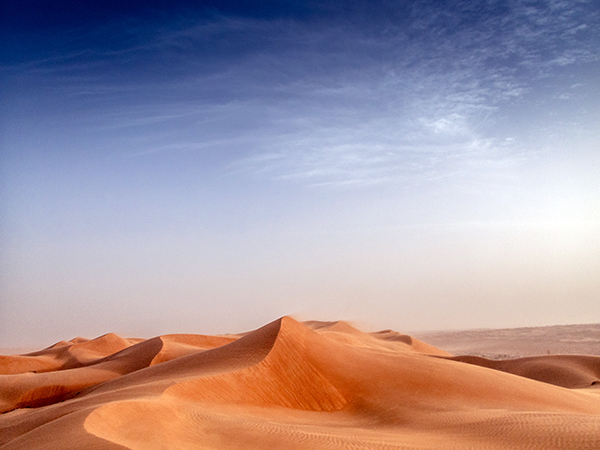
the Bin Ali tomb and mosque near Mirbat in the Dhofar governorate, southern Oman

the Musandam Peninsula

the Muttrah Corniche in Muscat

Wadi Darbat in Dhofar, southern Oman

the Wahiba Sands (aka Sharqiya Sands)


the Bin Ali tomb and mosque near Mirbat in the Dhofar governorate, southern Oman

the Musandam Peninsula

the Muttrah Corniche in Muscat

Wadi Darbat in Dhofar, southern Oman

the Wahiba Sands (aka Sharqiya Sands)

Sharqiya Sands, also known as Wahiba Sands after the local Bani Wahiba tribe, is roughly 4,000 square miles of sandy dunes in the north-east of our mystery country, about a two-hour drive from the national capital of Muscat. Along with several indigenous Bedouin groups inhabiting this desert, the high moisture content of the sand supports a surprising variety of flora and fauna. Heavy fog regularly rolls in off the sea and is absorbed by the sands.
There are lodges and tent camps in the Sharqiya Sands, but tourism, which has taken off across the country in recent years, may soon be limited to designated areas in order to preserve the unique and sensitive ecosystem.
Can you name that country?
See below for answers.

Wadi Darbat near Salalah in the southern govenorate of Dhofar shows off its Khareef green. The Khareef, or monsoon, rolls into Dhofar in late July and hangs around until September. While monsoon season may not sound inviting, the Khareef brings light drizzle, mist and fog, not torrential rains, and the normally brown, thirsty landscape springs to life. While the rest of this desert country bakes in summer heat, Dhofar is a paradise of gentle temperatures and lush scenery.

Sur

Wahiba Sands

Sur

Sultan Qaboos Grand Mosque, Muscat

Sultan Qaboos Grand Mosque, Muscat

Local musicians and dancers entertain tourists at this desert camp in the Sharqiya Sands (aka Wahiba Sands after a resident tribe). The golden dunes of Sharqiya Sands are located between the cities of Muscat and Sur in our mystery country. This Arabian Peninsula country is modern and prosperous, with a down-to-earth appeal that contrasts sharply with its glitzy neighbor to the west. The country’s considerable natural endowments include long, unspoiled coast lines on the Arabian Sea, Arabian/Persian Gulf and the eponymous gulf, Shangri-La valleys and rugged wadis tucked into the grand Al Hajar Mountains off the northern coast, expansive desert and an annual, mist-induced pop-up jungle in the southern mountains.

the National Museum of Oman, Muscat
The National Museum of Oman is a gleaming facility showcasing the culture and history of Oman. Some 5,000 artefacts, covering 2,000,000 years of human inhabitance are beautifully displayed in 14 airy galleries and labeled in Arabic and English (and Arabic Brail!) A clean, elegant design, both inside and out, spacious rooms and a soft palette create a very soothing atmosphere for a few hours submerged in the fullness of Oman. State-of-the-art Interactive displays, and video enhance the experience. It’s one of very few museums with “open storage,” which allows visitors access to items not currently on display. Conservation and restoration facilities are on-site, as well as a learning center open to kids of all ages.
The museum is centrally located in Muscat facing the Al-Alam Palace and adjacent to the Jalali and Mirani forts and the old city wall.

The lovely blue dome and minaret pictured belong to the Al Lawati Mosque in Muscat, the capital city of our mystery country. The mosque is a landmark in the Mutrah district of the city along the waterfront promenade or corniche. The Hajar Mountains provide a dramatic backdrop.
Can you name that country?
See below for answers.

At the Muttrah fish docks, fishermen unload the day’s catch to sell at the adjacent Muttrah Fish market. Many visitors to Muscat seeking an authentic experience, will rise with the sun and spend an hour or so browsing the stalls here. It’s an opportunity to observe an important local economy at work and to mingle with friendly locals. With a great variety of fish and sea food, it’s visually interesting, if a bit smelly.

inside the Sheikh Zayed Grand Mosque, Abu Dhabi

tea on the Nile

walking the Via Dolorosa in the Old City of Jerusalem

in the Royal Opera House of Muscat, Oman

riding through the streets of Trinidad de Cuba

Mutrah Souk in the capital is one of the oldest traditional markets in our mystery country and a favorite stop for visitors. Near the main entrance, there are plenty of shops offering the standard trinkets, as well as quality local products for tourists.
Buy frankincense of the best quality here (and many other places around the country), a product exported from this country for thousands of years. To round out the set, you can also find gold and myrrh at the Mutrah Souk. For a more authentic experience, head deeper into the maze of alleys, where locals shop.
Can you name that country?
See below for answers.